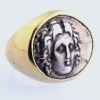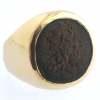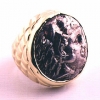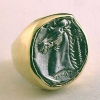|
Ancient Jewelry
|
|
 |
|
 |
|

Price :
$4600.00
Origin: Island of Rhodes
Circa: 490 BC to 322 BC
Collection: Classical Antiquities
Style: Greek Coin Bracelet
Medium: Silver and Gold
Additional Information: This More »
Origin: Island of Rhodes
Circa: 490 BC to 322 BC
Collection: Classical Antiquities
Style: Greek Coin Bracelet
Medium: Silver and Gold
Additional Information: This genuine Ancient Coin has Been Set in a Modern 18 karat Gold Ring « Less
|
|
Ancient Jewelry
|
|
|
|
|
| Vendor Details |
Close |
| Contact Info : |
| Barakat Gallery |
| 405 North Rodeo Drive |
| Beverly Hills |
| California-90210 |
| USA |
| Email : barakat@barakatgallery.com |
| Phone : 310.859.8408 |
|
|
|
|
|
|

Price :
$4800.00
Origin: Mediterranean
Circa: 350 BC
Collection: Coin Jewelry
Style: Greek
Medium: Silver, Gold
Additional Information: This coin was found in Asia Minor.
Some time More »
Origin: Mediterranean
Circa: 350 BC
Collection: Coin Jewelry
Style: Greek
Medium: Silver, Gold
Additional Information: This coin was found in Asia Minor.
Some time around 379 B.C. The region of Boeotia, northwest of Athens, grew radically in strength and obtained an influence throughout Greece, second to none in the entire Greek state. A new federal Boeotian currency w as put into circulation about this time which lasted down to the Macedonian conquest of Greece in 338 B.C. This silver stater is a remarkable example of the coinage minted during this period. On one side we see the beautiful image of an amphora, above which stands a cluster of grapes. Flanking the amphora is the name of one of the Boeotian magistrates, in abbreviated form, specially appointed to superintend the finances of the mint. The reverse side of the coin features a Boeotian shield. Mounted in its radiant gold ring setting, this extraordinary legacy of the Greek world is a work of art that is truly timeless in its ability to arouse the imagination and please the senses. - (FJ.5331) « Less
|
|
Ancient Jewelry
|
|
|
|
|
| Vendor Details |
Close |
| Contact Info : |
| Barakat Gallery |
| 405 North Rodeo Drive |
| Beverly Hills |
| California-90210 |
| USA |
| Email : barakat@barakatgallery.com |
| Phone : 310.859.8408 |
|
|
|
|
|
|

Price :
$3600.00
Origin: Mediterranean
Circa: 359 BC to 336 BC
Collection: Coin Jewelry
Style: Greek
Medium: Silver and Gold
Additional Information: The coin was found in northern Asia More »
Origin: Mediterranean
Circa: 359 BC to 336 BC
Collection: Coin Jewelry
Style: Greek
Medium: Silver and Gold
Additional Information: The coin was found in northern Asia Minor.
King Philip II was a man of great intelligence, skill, charm and energy. He was a hard fighter as well as a man of considerable cultural tastes. Ruthless and generous by turns, he passed many of his gifts for kingship on to his son, Alexander the great who brought Macedon to its greatest glory. After a youth partly spent as a political hostage in Thebes, Philip became king of Macedon in 359 B.C. At the age of twenty-three. Through conquest, treaty, bribery and marriage he stabilized his rule in Macedon and its surrounding territories. His tempestuous marriage to the Princess Olympias produced an heir, Alexander, in 356 B.C. Relations between husband and wife were often strained and both Olympias and Alexander have sometimes been implicated in the assassination of Philip in 336 B.C., following his marriage to Cleopatra- Eurydice. At the time of his death, Philip was planning a Panhellenic war against Persia, which w as successfully carried through by his son.This stunning silver tetradrachm minted during the reign of Philip II features on one side the dramatic portrait of the bearded king Philip II. The other side of the coin depicts a naked youth carrying a palm branch, symbol of peace, and riding a magnificent prancing horse. An inscription frames this radiant image. - (FJ.5349) « Less
|
|
Ancient Jewelry
|
|
|
|
|
| Vendor Details |
Close |
| Contact Info : |
| Barakat Gallery |
| 405 North Rodeo Drive |
| Beverly Hills |
| California-90210 |
| USA |
| Email : barakat@barakatgallery.com |
| Phone : 310.859.8408 |
|
|
|
|
|
|

Price :
$4600.00
Origin: Rhodes
Circa: 300 BC to 200 BC
Collection: Jewelry
Style: Greek Silver Coin Rings
Medium: Gold and Silver
This genuine ancient silver coin of Rhodes has been More »
Origin: Rhodes
Circa: 300 BC to 200 BC
Collection: Jewelry
Style: Greek Silver Coin Rings
Medium: Gold and Silver
This genuine ancient silver coin of Rhodes has been mounted in a modern 18 karat gold ring. - (FJ.5546) « Less
|
|
Ancient Jewelry
|
|
|
|
|
| Vendor Details |
Close |
| Contact Info : |
| Barakat Gallery |
| 405 North Rodeo Drive |
| Beverly Hills |
| California-90210 |
| USA |
| Email : barakat@barakatgallery.com |
| Phone : 310.859.8408 |
|
|
|
|
|
|

Price :
$2100.00
Origin: Egypt (Alexandria)
Circa: 247 BC to 222 BC
Medium: Bronze/Gold
Additional Information: This extraordinary coin is set in a stunning 18K gold ring.
The son of More »
Origin: Egypt (Alexandria)
Circa: 247 BC to 222 BC
Medium: Bronze/Gold
Additional Information: This extraordinary coin is set in a stunning 18K gold ring.
The son of Ptolemy II and his queen Arsinoe I, Ptolemy III acceded to the throne in 246 B.C. and married Berenice II, the daughter of king Magas of Cyrene. Ptolemy invaded Syria to support the claim of the son of his sister, Berenice Syra, to the Seleucid throne. This invasion soon turned into a war of vengeance after rivals murdered them. Ptolemy is said to have marched through the Seleucid Empire as far as Bactria, although extensive military conquests there were doubtful. He returned to Egypt to handle an uprising in the delta, and defeated an attack by Seleucus II in Coele-Syria. Eventually, peace was established between the two rulers with Ptolemy III receiving territory in Asia Minor and Thrace. Egypt remained at peace for the rest of Ptolemy’s reign but this led to a dangerous and unfortunate weakening of military strength. Upon his death in 221 B.C. his son Ptolemy IV succeeded him. This artistically rendered Ptolemaic coin, with its elegant gold frame, invites us to travel back in time, our imaginations conjuring up ancient life with all its complexity, intrigue and splendor. - (FJ.5641) « Less
|
|
Ancient Jewelry
|
|
|
|
|
| Vendor Details |
Close |
| Contact Info : |
| Barakat Gallery |
| 405 North Rodeo Drive |
| Beverly Hills |
| California-90210 |
| USA |
| Email : barakat@barakatgallery.com |
| Phone : 310.859.8408 |
|
|
|
|
|
|

Price :
$4200.00
Origin: Asia Minor
Circa: 300 BC
Collection: Coin Jewelry
Style: Greek
Medium: Silver/Gold
Additional Information: Set in an 18 karat gold ring.
During the 4th century More »
Origin: Asia Minor
Circa: 300 BC
Collection: Coin Jewelry
Style: Greek
Medium: Silver/Gold
Additional Information: Set in an 18 karat gold ring.
During the 4th century B.C., the Carthaginians issued silver tetradrachms in Sicily for the payment of mercenaries in the wars against the Greeks. Known as siculo-punic coins, these tetradrachms were stunning in both craftsmanship and imagery, as evidenced in this distinctive silver coin. The front of the tetradrachm depicts the head and neck of a magnificent horse. With mouth open wide and stylized mane flying in the wind, we can almost feel his ancient kinetic spirit. An accompanying image of a small palm tree appears to the right of the horse. On the reverse side of the coin the powerful head of the Greek God Heracles appears, one of the most popular deities in classical antiquity. Through the centuries his name has been synonymous with strength and adventure. Heracles was said to be the son of Zeus, king of the Olympian gods, and Alcmene, a mortal queen. His earliest feat of strength, performed while still in the cradle, was to strangle two serpents sent to kill him by Hera, jealous wife of Zeus. The tales about Heracles' adventures are the most numerous in ancient classical mythology. His most famous exploits are the "twelve labors,†difficult tasks performed with a mixture of skill, and cunning and sheer strength. Here, Heracles is depicted in a lion skinhead dress, representative of the first of his labors. How apropos that the Ancient Carthaginians should portray this fierce warrior on coins minted during their war with the Greeks. Today, the imagery on this magnificent coin, framed in a regal gold ring setting, is every bit as powerful as it was centuries ago. The spirited energy that emanates from the wild horse and the undefeated Heracles continue to express it most effectively. - (FJ.5719) « Less
|
|
Ancient Jewelry
|
|
|
|
|
| Vendor Details |
Close |
| Contact Info : |
| Barakat Gallery |
| 405 North Rodeo Drive |
| Beverly Hills |
| California-90210 |
| USA |
| Email : barakat@barakatgallery.com |
| Phone : 310.859.8408 |
|
|
|
|
|
|

Price :
$4800.00
Origin: Israel
Circa: 300 BC
Catalogue: V25
Collection: Coin Jewelry
Style: Greek
Medium: Silver, Gold
During the 4th century B.C., the Carthaginians issued silver More »
Origin: Israel
Circa: 300 BC
Catalogue: V25
Collection: Coin Jewelry
Style: Greek
Medium: Silver, Gold
During the 4th century B.C., the Carthaginians issued silver tetradrachms in Sicily for the payment of mercenaries in the wars against the Greeks. Known as Siculo-Punic coins, these tetradrachms were stunning in both craftsmanship and imagery, as evidence - (FJ.5722) « Less
|
|
Ancient Jewelry
|
|
|
|
|
| Vendor Details |
Close |
| Contact Info : |
| Barakat Gallery |
| 405 North Rodeo Drive |
| Beverly Hills |
| California-90210 |
| USA |
| Email : barakat@barakatgallery.com |
| Phone : 310.859.8408 |
|
|
|
|
|
|

Price :
$4600.00
Origin: Rhodes
Circa: 3 rd Century BC
Collection: Jewelry
Style: Greek Coin Rings
Medium: Silver and Gold
Additional Information: This coin was found in Asia Minor.
The More »
Origin: Rhodes
Circa: 3 rd Century BC
Collection: Jewelry
Style: Greek Coin Rings
Medium: Silver and Gold
Additional Information: This coin was found in Asia Minor.
The magnificent city of Rhodes, situated on the northern portion of the island of the same name, was an extremely prosperous city in the third century B.C. in fact; it became one of the principal trading centers of the ancient world, exercising much political influence through the strength of its maritime fleet. This magnificent silver coin evidences the wealth and prosperity of Ancient Rhodes. On one side the radiant face of the god hellos is featured. This actively mobile deity, roused daily by the crowing of the cock, drove the ancient sun across the heavens with his four-horse chariot. At night he would sail home along the ocean stream, which flows around the world, embarking his chariot and team on a golden ferryboat. The reverse side of the coin depicts a beautiful, multi-pedaled rose with a stemmed rose bud to the right. Imagery befitting a once-splendid city adorns this silver coin, at once captivating our imagination and drawing us like a siren to this ancient and memorable city by the sea. - (FJ.5723) « Less
|
|
Ancient Jewelry
|
|
|
|
|
| Vendor Details |
Close |
| Contact Info : |
| Barakat Gallery |
| 405 North Rodeo Drive |
| Beverly Hills |
| California-90210 |
| USA |
| Email : barakat@barakatgallery.com |
| Phone : 310.859.8408 |
|
|
|
|
|
|

Price :
$5800.00
Origin: Greece (Thessalonika)
Circa: 196 BC to 146 BC
Collection: Greek Silver Coin Ring
Medium: Silver/Gold
Additional Information: Mounted in a stunning 18 karat gold More »
Origin: Greece (Thessalonika)
Circa: 196 BC to 146 BC
Collection: Greek Silver Coin Ring
Medium: Silver/Gold
Additional Information: Mounted in a stunning 18 karat gold ring.
Thessaly is a vast plain in Central Greece, enclosed by mountains and drained by the river Peneios. In 197 B.C. the Romans, under the leadership of general Flamininus, won a great victory over Phillip V of Macedon, the ruler of Thessaly. The nominal freedom of the Greeks was proclaimed at Corinth at this time and a number of new autonomous Thessalian coinages were initiated. This stunning silver coin was minted during this period. One side of the coin features the laurelled head of Apollo, the Greek God of the sun. This dynamic Greek deity, roused daily by the crowing of the cock, drives the sun across the heavens with his four-horse chariot. At night he sails home along the ocean stream, which flows around the world, embarking his chariot and team on a golden ferryboat. The reverse side of the coin depicts the Greek Goddess of wisdom, Athena. According to myth, Athena’s father Zeus was suffering from an enormous headache and summoned Hephaistion the blacksmith God to split open his head and relieve the pain. When Hephaistion brought his hammer down on Zeus’ skull, Athena jumped forth fully-grown and wearing a suit of armor. Here Athena appears with her characteristic military attire. In her right hand she holds a spear while the left hand grasps a shield. A tangible and potent legacy, this extraordinary Thessalian coin speaks of a time when the great gods held sway over not only the heavens, but man's destiny as well. - (FJ.5731) « Less
|
|
Ancient Jewelry
|
|
|
|
|
| Vendor Details |
Close |
| Contact Info : |
| Barakat Gallery |
| 405 North Rodeo Drive |
| Beverly Hills |
| California-90210 |
| USA |
| Email : barakat@barakatgallery.com |
| Phone : 310.859.8408 |
|
|
|
|
|
|

Price :
$3600.00
Origin: Holy Land (Samaria)
Circa: 336 BC to 323 BC
Collection: Greek Silver Coin Ring
Medium: Silver/Gold
Additional Information: This coin is set in a beautiful 18 More »
Origin: Holy Land (Samaria)
Circa: 336 BC to 323 BC
Collection: Greek Silver Coin Ring
Medium: Silver/Gold
Additional Information: This coin is set in a beautiful 18 karat gold ring.
Depicting the head of Herakles, most popular of all Greek heroes, this exquisite coin evokes the splendor and romance of the ancient world. When we wear it in its magnificent setting, our imagination carries us into an age where legend and history become as one. This ring is for those who know that some of the best journeys in life are made in the mind. - (FJ.5930) « Less
|
|
Ancient Jewelry
|
|
|
|
|
| Vendor Details |
Close |
| Contact Info : |
| Barakat Gallery |
| 405 North Rodeo Drive |
| Beverly Hills |
| California-90210 |
| USA |
| Email : barakat@barakatgallery.com |
| Phone : 310.859.8408 |
|
|
|
|
|
|
|
|

|


